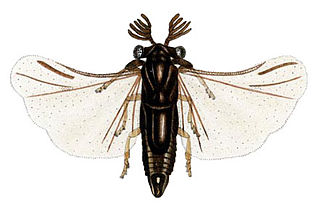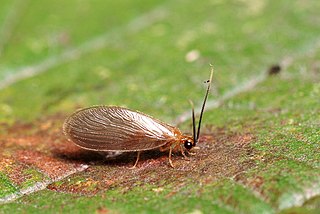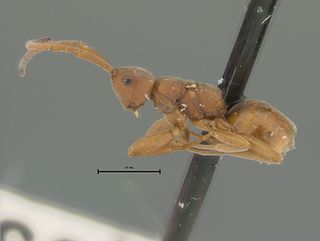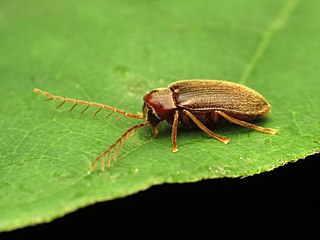
The Strepsiptera are an order of insects with eleven extant families that include about 600 described species. They are endoparasites in other insects, such as bees, wasps, leafhoppers, silverfish, and cockroaches. Females of most species never emerge from the host after entering its body, finally dying inside it. The early-stage larvae do emerge because they must find an unoccupied living host, and the short-lived males must emerge to seek a receptive female in her host. They are believed to be most closely related to beetles, from which they diverged 300–350 million years ago, but do not appear in the fossil record until the mid-Cretaceous around 100 million years ago.

Snakeflies are a group of predatory insects comprising the order Raphidioptera with two extant families: Raphidiidae and Inocelliidae, consisting of roughly 260 species. In the past, the group had a much wider distribution than it does now; snakeflies are found in temperate regions worldwide but are absent from the tropics and the Southern Hemisphere. Recognisable representatives of the group first appeared during the Early Jurassic. They are a relict group, having reached their apex of diversity during the Cretaceous before undergoing substantial decline.

The Lymexylidae, also known as ship-timber beetles, are a family of wood-boring beetles. Lymexylidae belong to the suborder Polyphaga and are the sole member of the superfamily Lymexyloidea.

Mantispidae, known commonly as mantidflies, mantispids, mantid lacewings, mantisflies or mantis-flies, is a family of small to moderate-sized insects in the order Neuroptera. There are many genera with around 400 species worldwide, especially in the tropics and subtropics. Only 5 species of Mantispa occur in Europe. As their names suggest, members of the group possess raptorial forelimbs similar to those of praying mantis, a case of convergent evolution.

Trigonalidae is one of the more unusual families of hymenopteran insects, of indeterminate affinity within the suborder Apocrita, and presently placed in a unique superfamily, Trigonaloidea, and the only extant taxon in the superfamily. The other putative related taxon is the extinct family Maimetshidae, known from the Cretaceous period. Trigonalidae are divided into 2 subfamilies; Orthogonalinae and Trigonalinae. These wasps are extremely rare, but surprisingly diverse, with over 90 species in 16 genera, and are known from all parts of the world. It is possibly the sister group to all Aculeata.

The Stephanidae, sometimes called crown wasps, are a family of parasitoid wasps. They are the only living members of the superfamily Stephanoidea. Stephanidae has at least 345 living species in 11 genera. The family is considered cosmopolitan in distribution, with the highest species concentrations in subtropical and moderate climate zones. Stephanidae also contain four extinct genera described from both compression fossils and inclusions in amber.

Evaniidae is a family of parasitoid wasps also known as ensign wasps, nightshade wasps, hatchet wasps, or cockroach egg parasitoid wasps. They number around 20 extant genera containing over 400 described species, and are found all over the world except in the polar regions. The larvae of these solitary wasps are parasitoids that feed on cockroaches and develop inside the egg-cases, or oothecae, of their hosts.

Sisyridae, commonly known as spongeflies or spongillaflies, are a family of winged insects in the order Neuroptera. There are approximately 60 living species described, and several extinct species identified from the fossil record.

The dustywings, Coniopterygidae, are a family of Pterygota of the net-winged insect order (Neuroptera). About 460 living species are known. These tiny insects can usually be determined to genus with a hand lens according to their wing venation, but to distinguish species, examination of the genitals by microscope is usually necessary.

The Brachypsectridae are a family of beetles commonly known as the Texas beetles. There are only two extant genera, Brachypsectra and Asiopsectra. Brachypsectra has a cosmopolitan distribution, mostly in arid regions, while Asiopsectra is found in Central Asia and the Middle East.
The Scolebythidae are a small family of aculeate wasps in the superfamily Chrysidoidea. These chrysidoid wasps are found in Africa, Australia, the Neotropics, north China, Thailand and Fiji. They are parasites on larvae of Cerambycidae and Ptinidae.

Embolemidae is a family of small solitary parasitoid wasps with around 70 species in 2 genera distributed around the world. The few species whose biology is known are parasites on planthopper nymphs of the families Achilidae and Cixiidae. There is debate regarding the status of the genus named Ampulicomorpha by Ashmead in 1893, generally considered now to be a junior synonym of Embolemus (e.g.,), though some authorities dispute this (e.g.,)

Ptilodactylidae is a family of beetles belonging to the Elateriformia. There around 500 extant species in 35 genera. They are generally associated with riparian and aquatic habitats. The larvae generally live associated with rotting wood or vegetation, or within gravel and detritus on the edge of water bodies. The larvae of some species feed on submerged rotting wood or on plant roots, while the adults of some species are known to feed on fungus with modified brush-like maxillae.

Throscidae is a family of elateroid beetles found worldwide with around 150 species in 5 extant genera. The larvae are soil-dwelling, siphoning fluid from mycorrhizae attached to trees. The adults are short-lived, with the adult males being noted for a complex mating dance. Like some other elateroids, they are capable of clicking.
2018 in paleoentomology is a list of new fossil insect taxa that were described during the year 2018, as well as other significant discoveries and events related to paleoentomology that were scheduled to occur during the year.
2019 in paleoentomology is a list of new fossil insect taxa that were described during the year 2019, as well as other significant discoveries and events related to paleoentomology that were scheduled to occur during the year.
2017 in paleoentomology is a list of new fossil insect taxa that were described during the year 2017, as well as other significant discoveries and events related to paleoentomology that were scheduled to occur during the year.
2015 in paleoentomology is a list of new fossil insect taxa that were described during the year 2016, as well as other significant discoveries and events related to paleoentomology that were scheduled to occur during the year.
This paleoentomology list records new fossil insect taxa that were to be described during the year 2021, as well as notes other significant paleoentomology discoveries and events which occurred during that year.
This paleoentomology list records new fossil insect taxa that are to be described during the year 2022, as well as notes other significant paleoentomology discoveries and events which occurred during that year.














